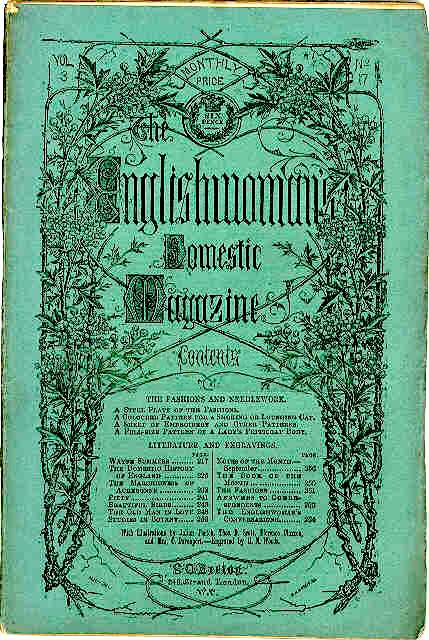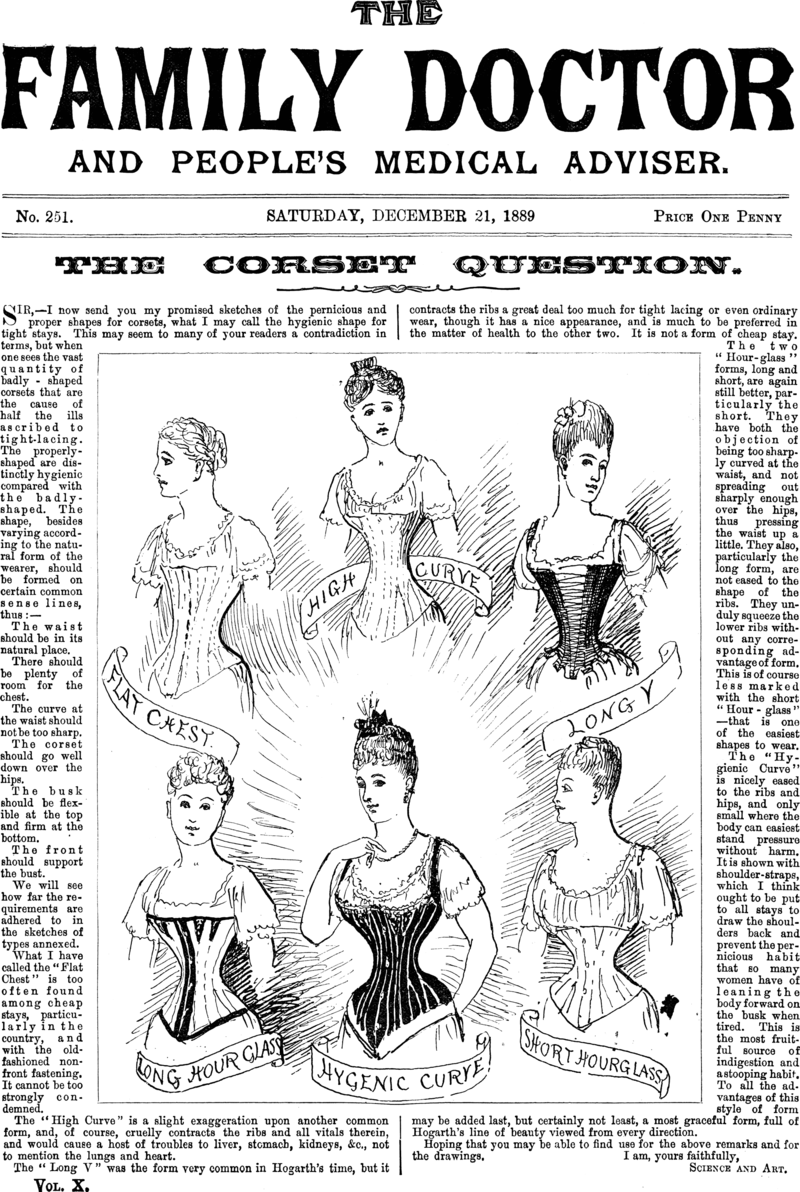Early Media Impressions of TGs — Footprints From The Past
By Andee W
We all react to the stereotypes of the transgendered in the mainstream media. If you are like me you don’t find much in common with the spectacle on Jerry Springer or the other television talk shows. We’re not really like that. But the media has been fascinated by us for a long time.
Some of the more telling media artifacts are from over a hundred years ago, and continued to show up in varied publications well into the early twentieth century. From 1867-1873 The Englishwoman’s Domestic Magazine often featured letters from men to the editor who told how much they enjoyed wearing corsets, describing “petticoat punishment,” i.e. — forced crossdressing as an alternative to corporal punishment, and the pleasures of female clothing.
One example, titled Etonesis, is an interesting account from the magazine in 1870 about a governess and maid who dressed a young man in his sister’s clothes for not completing a geography lesson:
“Stays were easy, but now came the fight again. The first petticoat I clutched hold of, and I think for ten minutes I held on ’til at last that too was accomplished…They now easily accomplished the rest; shame overcame my courage, and I had no strength. My trousers were now entirely removed. I was made to stand up, under more slappings and thumpings, and threatenings of birch, while my dressing was most leisurely completed with a stiff starched petticoat, a blue frock nearly down to my feet, stockings, and sandal shoes…I know not if this punishment is more cruel than the birch; the mere threat ‘shall I send for some petticoats for you?’ always sets me to work.”
Another publication of the era was The Family Doctor and People’s Medical Adviser, published from 1885-1894. It endeavored to provide practical medical advice to families, and was particularly adamantly against the practice of “tight-lacing.”
In reaction to its articles, from 1886 on men were writing in about the pleasures of full female dress. One letter was in response to an offer (in another letter from a female who wore men’s clothes) to provide an entire outfit to any man who would show himself in the full dress of a woman on Regent Street at a prearranged time.
Josephine (formerly Joseph) writes: “I have always suffered from a weak throat, and during a great part of the year I am obliged to keep my neck and chest well wrapped up. Returning home rather late once, a lady friend lent me her fur boa. I found so much comfort in its use that I decided to get one.
The Eternal Question…
“I did this, and wore it, with the result I became an object of ridicule. I then reasoned that if so much comfort could be obtained from one article of female attire, how much might I expect from assuming such entirely?
“I tried it, and was more than satisfied, and decided for the future to discard male dress. I confessed my feeling in the matter to a friend of mine, an elderly lady, who approved of my plan. For the last four years I have been living with her as her niece, a quietly dressed and modestly conducted young lady.”
In another letter, titled A Would-Be Petticoat, a man writes: “Some time back, when so much talk was made as to whether a woman’s dress was healthful and convenient, I determined to practically test the fact for myself. I accordingly encased myself in lady’s full costume for one month, at the end of which time, whenever the opportunity presents itself in the privacy of my own home, I don female attire. In order to gratify my wish I have a complete lady’s wardrobe of my own, of which I am very particular, especially my underclothing, which I cannot have too nice; although when fully dressed it is not seen, still the consciousness that it is there is a source of great pleasure to the wearer, a statement many ladies, I know, will endorse.”
Another contemporary publication of the time was Society, published from 1879 to 1900. It too jumped into the corset controversy. One letter to the editor provided this account of a young man pressed into bridesmaid’s duty because his sister was sick:
“On rising in the morning (if my sisters desire me to accompany them in female rigout) I wear thin silk ‘combinations’, over which the corset is laced fairly tight. Coloured silk lingerie, and a soft morning gown completes the outfit. After breakfast a few hours of recreation follow, and then we retire to our rooms, mine being that occupied until lately by my married sister. Once there, the maid comes round to each, and the silken corset laces are tightly drawn to the extreme of tightness, nineteen inches never being exceeded. The silken undergarments are supplanted by white lawn, smothering with frills and laces, and each emerges from the room looking delightfully comfortable and happy.
“As I am writing this I am arrayed in a grey tweed dress, having been out walking. At every moment I hear the fascinating creak of a new satin corset, every movement of my limbs followed by the swish of silken garments, a delicate perfume comes from the pink satin with which the skirt is lined, and when I cross my feet in true ‘tomboy fashion’ I can see a filmy cloud of white lace hovering over high heel Parisian shoes.”
As the end of the last century approached, periodicals and newspapers were thriving and always on the prowl for items that would interest and entertain their readership. The “corset controversy” and “tight-lacing” were subjects that elicited many letters to the editor, and quite a few were from men who related their crossdressing experiences. Above I related a letter to Society from a young man from Dublin who had to fill in for a sick sister as a bridesmaid, and was then treated like one of the girls. These next letters are also from Society. The first, entitled Satin Waist, was published in September 1899.
“My sister and I live in a very quiet place, and a great deal of the days are spent in looking after stock, etc. Very often I am on my feet all day, and come in at night fagged and footsore. It is then that the real comfort of a satin corset fitting like a glove is experienced. At first I merely wore the stays under my ordinary clothes, but after a while, my sister decided that it would be much better to complete my outfit, and I was forthwith initiated into a bewildering mass of lace-trimmed undergarments. Now when my day’s work is over, I have a hot bath, and come down to dinner a different being, and enjoying myself thoroughly, generally wearing a plain, tight-fitting costume in black satin.”
Society seemed to be on a roll with the crossdressing theme, and over the next few months had quite a few letters on the subject. This one is from the spring of 1900, entitled Tablier Blanc, and was written from the perspective someone unemployed who found more than just a new job.
“I have lived as a woman for the last two years, and am doing so still, so it may interest your readers if I give you a glimpse of my experience. I have always had a great penchant for dressing in girl’s clothes — many of your correspondents appear to have the same — and one evening my sister suggested to me that I should apply — as a girl — for a vacant situation as a barmaid at the restaurant where she was employed. This I secured, and, thanks to a slim figure, small hands and feet, and dark curly hair, I do not think my sex has ever even been suspected.”
The last letter this month was published in the next Society issue of 1900. It is entitled Martyr, and is about a young man’s Victorian adoption experience.
“I was adopted when young by a lady of considerable wealth who was devoted to dress and fashion. I was just fourteen when this lady — who, in a year’s time was to travel abroad — decided, partly I think out of caprice, partly for convenience sake, to take me with her disguised as a girl. I dare say she was influenced by my effeminate appearance and complexion, and slender slight figure. A fashionable dressmaker was consulted, and I was furnished with a large outfit of garments of the latest fashion and most dainty cut and material. In particular, great care was taken over my figure. I had of course to wear false hair, until my own grew long, and I was most carefully instructed in ladylike manners and deportment. When we went abroad, my dainty complexion and hands, very smartly shod feet, and extremely slim waist, and well moulded figure, were the objects of much adoration and envy. There was not the slightest danger of anyone suspecting that the pretty well-dressed girl, apparently of about sixteen, was really an unfortunate boy. I had to endure three years of this bondage, and became so soft and effeminate that, when the death of the lady who adopted me made me independent, I went back to the garb and habits of my own sex with reluctance and difficulty.”
Care to make a comment on this post? Login here and use the comment area below.
Category: Transgender Body & Soul, Transgender Fun & Entertainment













